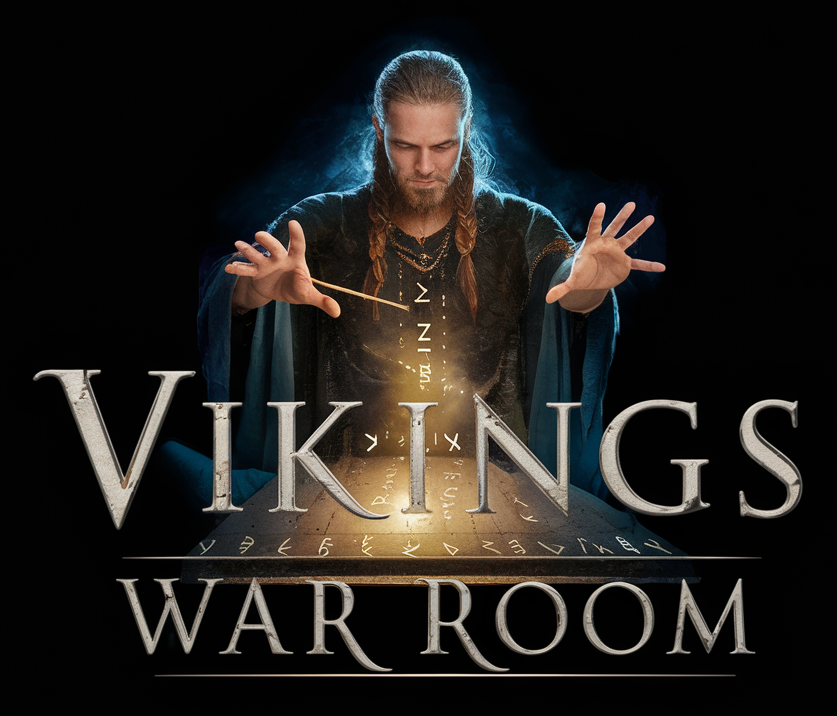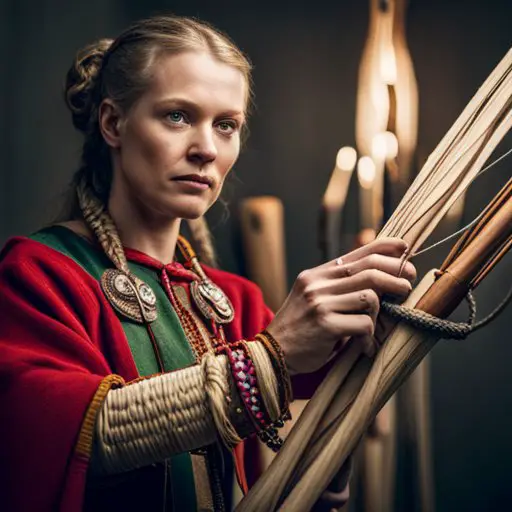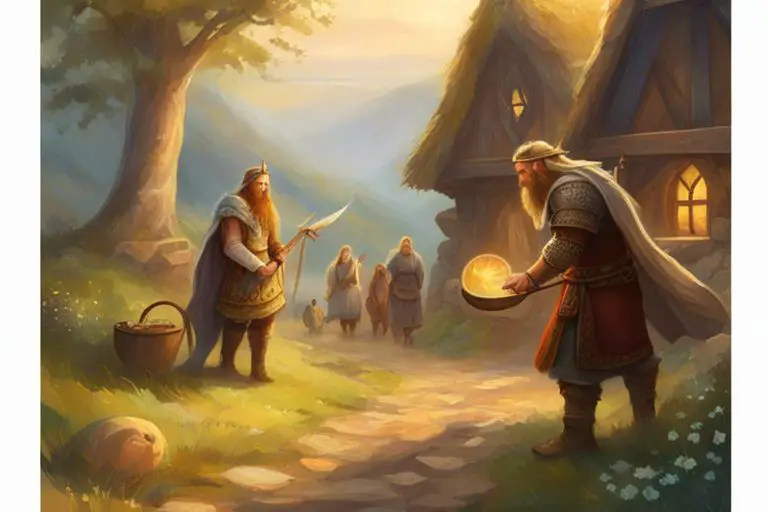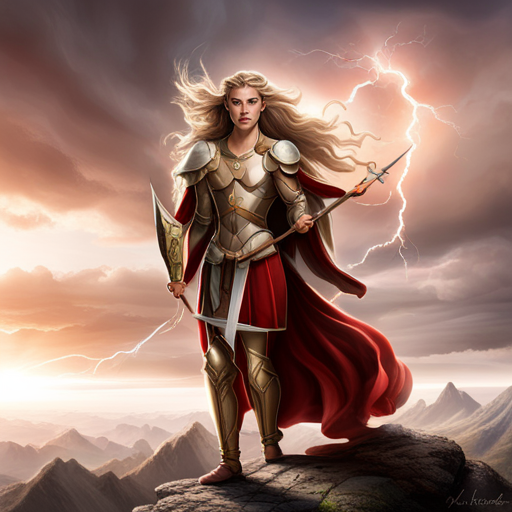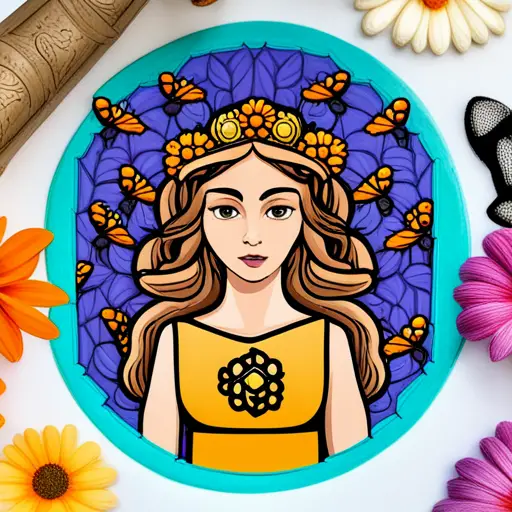As a lover of history and fashion, I have always been fascinated by the Viking era and its unique style.
The Viking people were known for their fierce warriors, seafaring adventures, and intricate craftsmanship, but their clothing and accessories were also a vital part of their culture.
From their fur-lined cloaks to their intricate brooches, Viking fashion was both functional and beautiful, providing insight into the values and traditions of this ancient society.
In this article, we will explore the influence of weaving tradition on Viking fashion, the types of clothing and accessories worn by the Viking people, the materials used in their creations, and the weaving techniques employed to achieve their designs.
We will also delve into the Norse culture and traditions reflected in Viking style, uncovering the deeper meanings behind the garments and accessories worn by these legendary people.
Join me on this journey through time as we discover the secrets of Viking clothing and accessory design and the traditions that continue to inspire modern fashion.
The Influence of Weaving Tradition on Viking Fashion
We can see how the timeless techniques of weaving have seamlessly integrated into the fashion of the Northmen, imbuing their garments with a rich history and cultural significance.
For the Vikings, weaving wasn’t just a practical skill, but a form of art that they used to express themselves and their identity. They created intricate patterns and designs that were not only aesthetically pleasing but also held symbolic meaning.
The colors and patterns used in Viking clothing were often inspired by nature, with greens and blues representing the sea and earthy tones symbolizing the land.
The Vikings’ love for weaving is evident in the variety of textiles they used to create their clothing and accessories. Wool was the most common material, as it was readily available and provided warmth during harsh winters. But they also used linen, silk, and even animal skins to create unique and luxurious pieces.
In the next section, we’ll explore the different types of clothing and accessories that the Vikings created using these textiles and weaving techniques.
Types of Viking Clothing and Accessories
From tunics and trousers to brooches and belts, the various articles of clothing and adornments worn by the Norse people were both functional and fashionable.
The tunic, for example, was a staple garment worn by both men and women, made from wool or linen and often embellished with decorative trim.
Trousers, known as trews, were also commonly worn and could be made from leather or wool.
Women wore a long dress called a smokkr, which was typically made from linen or wool and fastened at the shoulders with brooches.
Accessories were just as important as clothing for the Vikings.
Brooches were used to fasten garments, with intricate designs and precious metals indicating the wearer’s social status.
Belts were also worn, often made from leather and adorned with metalwork.
Hats and caps were popular headwear, with styles ranging from simple woolen caps to fur-lined hats.
The Vikings also wore jewelry, including arm rings, necklaces, and earrings, often made from silver or gold and decorated with intricate patterns.
As we delve deeper into the world of Viking clothing and accessories, it’s important to understand the materials used to create these pieces.
Let’s explore the fibers and fabrics that were commonly used in Norse fashion.
Materials Used in Viking Clothing and Accessories
The materials used in creating garments and adornments during this era were varied, with wool, linen, leather, and precious metals being some of the most commonly used.
Wool was the most prevalent fabric used in Viking clothing due to the abundance of sheep. Linen was also used, but mainly for undergarments.
Leather was used for shoes, belts, and other accessories, and was often decorated with intricate designs. Precious metals such as gold and silver were used to create jewelry and brooches, which were often adorned with intricate patterns and designs.
The Vikings were known for their resourcefulness, and they utilized every part of an animal in their clothing and accessory designs. For example, they would use the fur and hide of animals to create warm and durable outerwear.
They also used natural dyes to color their fabrics, using plants such as madder, woad, and weld.
The materials used in Viking clothing and accessories were not only practical, but also reflected the culture and environment in which they lived.
In the next section, we’ll explore the weaving techniques employed in Viking fashion.
Weaving Techniques Employed in Viking Fashion
Using the metaphor of a spider’s web, Viking fashion employed intricate weaving techniques to create durable and beautiful garments from natural materials. These techniques included tablet weaving, which involved the use of small wooden tablets to create intricate patterns in the fabric.
Other methods included warp-weighted loom weaving, which was used to create larger pieces of fabric, and sprang weaving, which created stretchy fabrics without the use of a loom.
These weaving techniques were not only functional, but also served as a form of artistic expression. Viking clothing and accessories were often adorned with intricate patterns and designs, showcasing the weaver’s skill and creativity.
The use of natural materials such as wool, linen, and leather also reflected the Norse culture’s connection to the natural world and their appreciation for its resources. Through their weaving traditions, the Vikings were able to not only create practical clothing and accessories, but also to express their cultural values and beliefs.
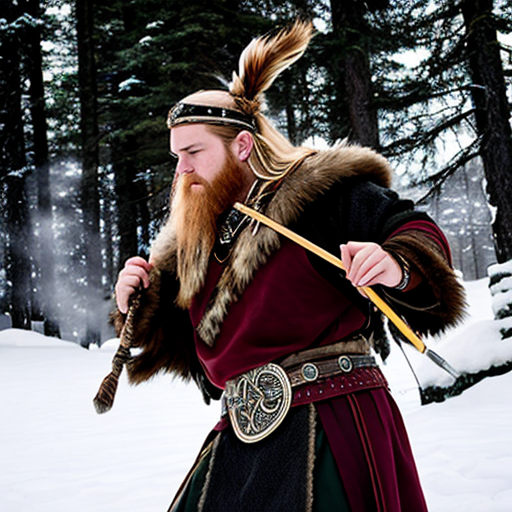
Norse Culture and Traditions Reflected in Viking Style
It’s fascinating to see how the Norse culture and traditions are reflected in the way the Vikings dressed and presented themselves. The Vikings were known for their love of adornment, and their clothing and accessories were no exception. They valued intricately woven textiles, intricate metalwork, and other embellishments that highlighted their status and wealth. They also incorporated elements of their environment, such as the use of fur and leather to keep warm in cold climates.
The Vikings’ love of storytelling was also evident in their clothing and accessories. Many of their items were adorned with intricate designs that told stories of their gods and heroes. For example, the Valknut symbol, which is three interlocking triangles, was believed to be a symbol of Odin and was often used in Viking art and clothing.
The Vikings also incorporated animal designs into their clothing and accessories, such as the wolf and serpent, which were believed to have powerful protective qualities. Overall, the Vikings’ use of traditional Norse elements in their clothing and accessories served as a way to connect with their heritage and showcase their status and power.
Frequently Asked Questions
How did Vikings learn to weave and create clothing and accessories?
Learning to weave and create clothing and accessories was a challenging yet rewarding experience for the Vikings. Let’s just say I had to get creative with my methods.
It wasn’t just about creating something to wear, but it was a symbol of status and pride. I learned by observing and asking questions from those who had experience, and trial and error was my best teacher.
Weaving was a skill that required patience and attention to detail, but the end result was worth it. It was a way to connect with my community and showcase my craftsmanship.
What were the typical colors used in Viking clothing and accessories?
When it comes to Viking clothing and accessories, the colors used were typically earth tones such as browns, greens, and blues. These colors were derived from natural sources such as plants and minerals found in the Viking’s environment.
As a lover of all things Viking, I find myself drawn to these colors as they represent the connection to nature that the Vikings valued so highly. It’s amazing to think that even centuries later, we can still appreciate and incorporate these colors into our modern fashion and style.
Did Vikings have any restrictions or rules on the types of clothing they could wear?
It’s funny to think that Vikings, known for their fearsome approach to battles and conquest, would have any restrictions on what they could wear. But the truth is, they did.
Despite their reputation for being wild and unconstrained, Vikings had a set of social norms and expectations that governed their clothing choices. For example, certain fabrics and colors were reserved for the upper classes, and there were strict rules around how much jewelry one could wear.
These rules helped to reinforce the social hierarchy, and ensured that everyone knew their place. It’s fascinating to see how even the most seemingly free-spirited cultures had their own set of traditions and restrictions.
Were there any specific symbols or patterns commonly used in Viking weaving and design?
When it comes to Viking weaving and design, there were definitely some specific symbols and patterns that were commonly used.
As someone who’s always been fascinated by Norse culture, I find it really interesting to see how these motifs were incorporated into clothing and accessories.
For example, the Valknut symbol – which is made up of three interlocking triangles – was often woven into fabric and used on clothing.
The Mjolnir, or Thor’s hammer, was another symbol that was commonly used in Viking design.
As someone who loves to express my interests through my clothing and accessories, I think it’s really cool to see how these symbols are still being used today in modern interpretations of Viking fashion.
How did Viking fashion and style change over time and with different regions?
Have you ever wondered how fashion evolved during the Viking era? As I delved into the history of Viking clothing and style, I discovered that fashion was not stagnant and varied depending on the region and time period.
For instance, during the early Viking age, clothing was simple and practical, and wool was the predominant material used in weaving. As time passed, silk and other exotic fabrics found their way into Viking fashion, and embroidery became a popular way to add decorative elements.
Additionally, different regions had their own unique styles, such as the intricate brooches and colorful patterns of the Bryggen region. Overall, Viking fashion was not a monolithic entity and was influenced by various factors that evolved over time.
Conclusion
In conclusion, exploring the world of Viking fashion has been an eye-opening experience. It’s fascinating to see how weaving tradition has influenced their clothing and accessories, and how Norse culture and traditions are reflected in their style.
From the intricate designs to the materials used, every aspect of Viking fashion tells a unique story. One interesting statistic I came across during my research is that wool was the most commonly used material in Viking clothing. It was readily available and provided warmth during the harsh Scandinavian winters.
It’s amazing to think that something as simple as wool played such a significant role in Viking fashion. Overall, studying Viking clothing and accessory design has given me a newfound appreciation for the artistry and creativity that went into their style.
It’s a reminder that fashion is not just about looking good, but also about telling a story and preserving a culture.
